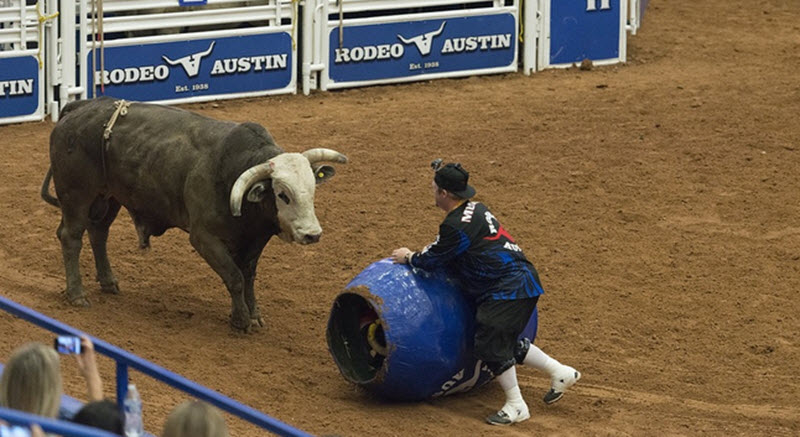Rodeo clown
A rodeo clown works in bull riding competitions. Originally, the rodeo clown would have two jobs: protecting fallen riders during the bullriding segment by acting as a bullfighter (thereby distracting the bull) and provide comic relief during breaks between the various competitions and performances at the rodeo. The comic numbers would often involve parodies of cowboy culture.
Today, many of the larger rodeos in the United States hire several different people for these jobs, i.e. one bullfighter who carry out bullfighting only and team of entertainers (clowns, etc) who provide comic relief. With smaller rodeos, it is still common to see the rodeo clown carrying out all these various tasks.

Rodeo bullfighter
When a bullrider has been bucked off or has jumped off the bull, the rodeo clown will help distract the bull and provide the bull with an alternative traget to attack. At larger events, two or more bullfighters may work together in the arena.
A good bullfighter will be fast and agile, and have the ability to engage the bull and anticipate the bull’s next move.
Rodeo bullfighters wear one layer of protective gear and a second layer of loose-fitting clothes. The loose-fitting clothes are designed to tear away easily of the bull gets hold of them. In some rodeos, bullfighters still wear clown clothes and clown makeup.
The job of the bullfighter is a dangerous one, and injuries are common. Bullfighters have been killed on the job or died later from injuries sustained during a bullfight.
Technique
The rodeo bullfighter will enter the arena on foot before the bull is released from the bucking chute. If more than one bullfighter is present, they will position themselves on either side of the chute and work as a team to protect not just a fallen bullrider but also themselves.
Examples of techniques commonly employed by rodeo bullfithers:
- Putting themselves between the bull and the fallen bullrider (especially common when the rider has been injured and can’t get out of harms way on their own).
- Running off at an angle
- Hat throwing
- Shouting to get the attention of the bull
If a bullrider has been hung up, the bullfighters will try to free the rider – a very dangerous task. This duty is best carried out by two or more bullfighters working together, so that at least one person can go to the bull’s head while at least one other person works on releasing the rider.
Heckling
It is common for rodeo clowns to engage in heckling to amuse the crowd. The clown will be equipped with a microphone and heckle the rodeo announcer, the bull, the crowd, selected members of the crowd, etc.
History of the rodeo clown
Competitive rodeo events became commonplace in the early 20th century, and soon the rodeo promoters began hiring cowboys to provide entertainment in between the competitive events. Originally, these cowboys wore oversized clothing, and this habit eventually developed into more and more outlandish outfits.
In the 1920s, using very agressive Brahma bulls for bullriding became popular, since it made the bullriding contests more dangerous – and thus more exiting for the crowd. Soon, it became apparent that something needed to be done to reduce the risk of serious injury for fallen bullriders. The solution was to send in one or more rodeo clowns to act as bullfighters; drawing the attention of the bull away from the fallen rider and onto themselves.
The barrel
In the 1930s, a rodeo clown named Jasbo Fulkerson started using a wooden barrel with a solid bottom to protect himself and the fallen bullrider. This practise caught on and was embraced by many other rodeo clowns.
Today, larger rodeos will sometimes have a designated barrelman who is responsible for handling the barrell and works together with clowns and bullfighters. A common combo is two free-roaming bullfigthers + one clownish barrelman. The typical barrel will be large, made from steel and have a lot of padding. In dangerous situations, the barrelman can jump into the barrel and then out of it again, to both protect himself and draw the attention of the bull away from other people in the arena.
Competitions & Performances
Eventually, rodeo bullfighting grew into a competive event in its own right in the United States. Bullfighters also began having their own individual performances where they were showcasing their bullfighting skills without having any fallen bullrider in the arena to worry about.
Examples of elements typically included in rodeo bullfighting performances and contests:
- Bull maneuvering
- Precision jumping
- Bull contact
- Barrel handling
Unlike Spanish bullfighting, the United States rodeo bullfighter is not supposed to kill or even injure the bull.